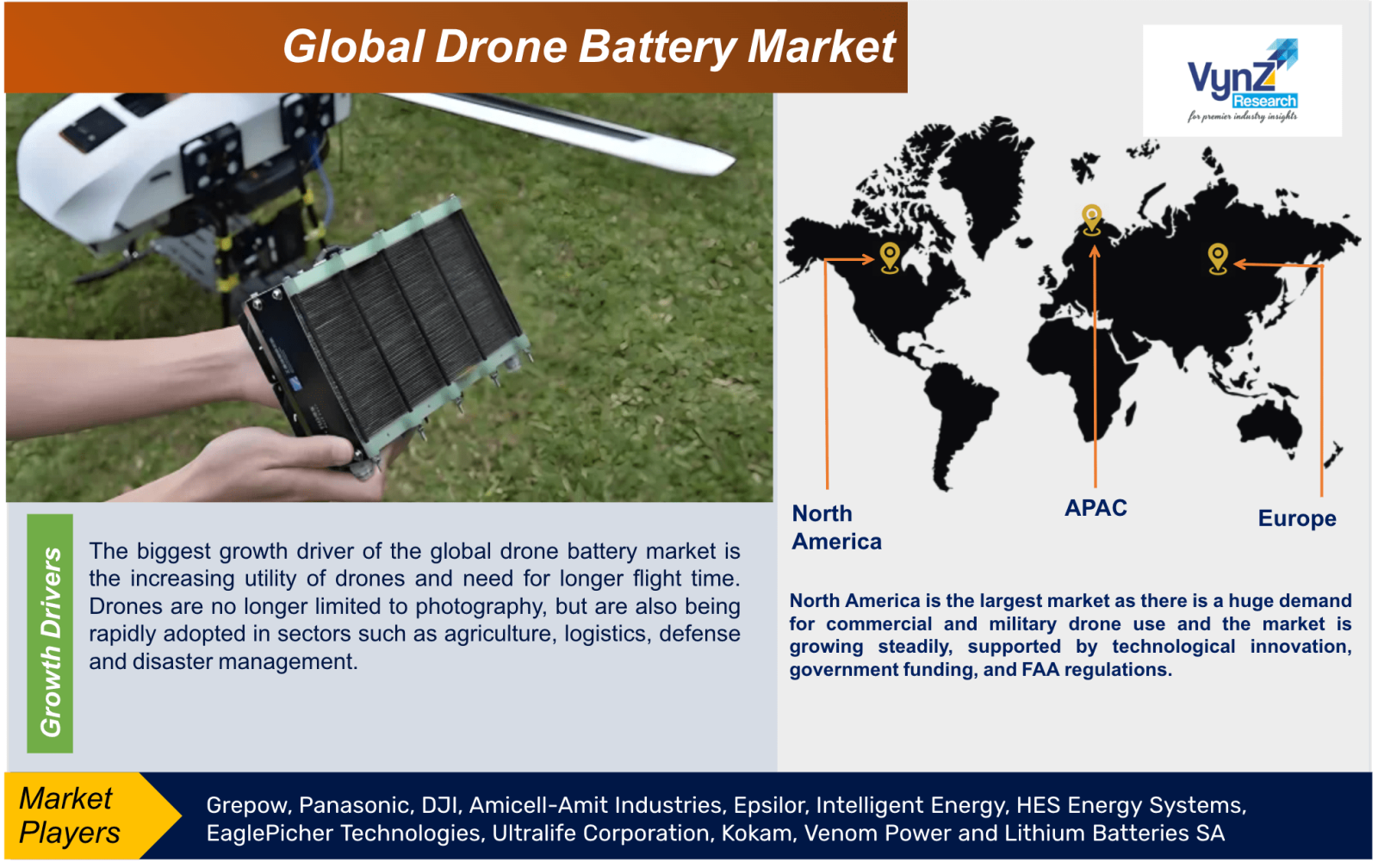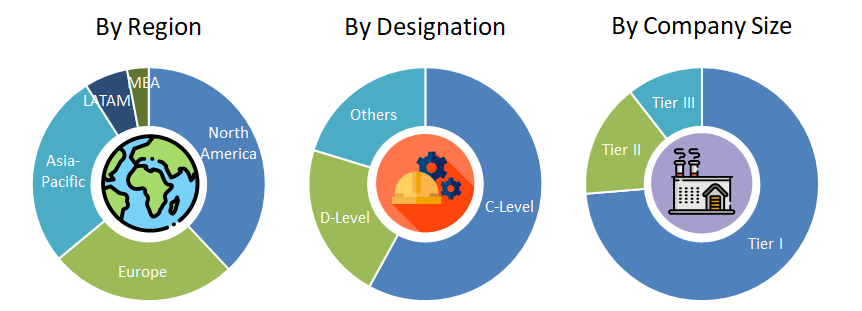Global Drone Battery Market Size & Share | Growth Forecast Report 2035
Industry Insights By Battery Type (Lithium-Polymer, Lithium-Ion, Nickel-Cadmium and Others), By Capacity (<3000 mAh, 3000–10000 mAh, and >10000 mAh. 3000–10000 mAh), By Configuration (3S, 4S, 6S and Others), By End Use (Commercial, Consumer, Industrial and Defense) and By Geography (North America, Europe, Asia Pacific, Rest of the World)
| Status : Published | Published On : Sep, 2025 | Report Code : VRSME9174 | Industry : Semiconductor & Electronics | Available Format :

|
Page : 136 |
Global Drone Battery Market Size & Share | Growth Forecast Report 2035
Industry Insights By Battery Type (Lithium-Polymer, Lithium-Ion, Nickel-Cadmium and Others), By Capacity (<3000 mAh, 3000–10000 mAh, and >10000 mAh. 3000–10000 mAh), By Configuration (3S, 4S, 6S and Others), By End Use (Commercial, Consumer, Industrial and Defense) and By Geography (North America, Europe, Asia Pacific, Rest of the World)
Industry Overview
The Global Drone Battery Market size was valued at USD 1.3 billion in 2025. It is likely to grow up to USD 2.8 billion by 2035 at a CAGR of 8.5 % during the forecast period ranging between 2026 and 2035.

Fast charging technology and operational efficiency are pushing the market growth. Battery charging in less time increases the efficiency of business applications such as delivery and surveillance operations and this is why companies are now adopting rapid charging and battery swap systems.
A drone battery is a power unit that provides energy to the motor, sensors, and camera during flight. Lithium-polymer (Li-Po) and lithium-ion (Li-ion) batteries are most commonly used these days. These batteries are lightweight but provide long-term flight capability and stable performance. Technologies like fast charging, high energy density, and safety control systems make them even better.
Drone batteries are used in many areas such as photography, agriculture, survey, delivery, and surveillance. They are also being widely used in areas such as military, police, television, and traffic management.
Global Drone Battery Market Report Coverage
|
Report Metric |
Details |
|
Historical Period |
2020 - 2024 |
|
Base Year Considered |
2025 |
|
Forecast Period |
2026 - 2035 |
|
Market Size in 2025 |
U.S.D. 1.3 Billion |
|
Revenue Forecast in 2035 |
U.S.D. 2.8 Billion |
|
Growth Rate |
8.5% |
|
Segments Covered in the Report |
By Battery Type, By Capacity, By Configuration, By End Use |
|
Report Scope |
Market Trends, Drivers, and Restraints; Revenue Estimation and Forecast; Segmentation Analysis; Impact of COVID-19; Companies’ Strategic Developments; Market Share Analysis of Key Players; Company Profiling |
|
Regions Covered in the Report |
North America, Europe, Asia Pacific, Rest of the World |
Drone Battery Industry Dynamics
Drone Battery Market Trends/ Growth Drivers:
The biggest growth driver of the global drone battery market is the increasing utility of drones and need for longer flight time. Drones are no longer limited to photography, but are also being rapidly adopted in sectors such as agriculture, logistics, defense and disaster management. The need for frequent, stable and long-duration flying in these sectors has increased the demand for high-capacity batteries. Users now want drones that can cover long distances and perform multiple tasks on a single charge. To meet this demand, companies are focusing on energy density and charge holding capacity in batteries. New batteries with high power output and better cooling technology are meeting this need. Compact size and lightweight design are also driving the demand while promoting portability.
Other key growth drivers and market trends include efficient technologies such as lithium-silicon and solid-state batteries, modular battery systems, rising demand for eco-friendly and recyclable batteries, changes in government regulations, predictive maintenance, and growing demand for high performance batteries.
Drone Battery Market Challenges
Limited battery life and power density
Today, most drone batteries still offer very limited flight time, hindering commercial use. Efforts to increase power density are not able to strike a balance between cost and safety. Long charging times affect operational efficiency, especially in services such as delivery and surveillance. Batteries are also susceptible to failure if exposed to high temperatures, shock or water and high R&D costs and time taken to develop new batteries leave small manufacturers behind.
Drone Battery Market Opportunities
Growing demand for high-endurance batteries
The need for long-lasting batteries for long-range and high-payload drones has become a major opportunity. The growing role of drones in smart cities, agriculture and transportation is rapidly opening up opportunities in the battery market. Extreme weather-resistant batteries for military and disaster relief operations are seeing huge demand and investments in lithium-silicon and solid-state battery technology are driving a new wave of innovation.
Recent Developments by the Key Players
Panasonic Energy Co. has officially opened its lithium-ion battery factory for electric vehicles in De Soto, Kansas, and has started mass production of 2170 cylindrical lithium-ion cells at the plant.
The Civil Aviation Authority (CAA) and Intelligent Energy (IE) partnered to guarantee zero-emission hydrogen-powered flights in the United Kingdom. As the first generation of fuel-cell-powered passenger aircraft is expected to fly this decade, the partnership will be crucial to guaranteeing their safe operation.
Global Drone Battery Market Segmentation
VynZ Research provides an analysis of the key trends in each segment of the Global Drone Battery Market report, along with forecasts at the regional and country levels from 2026-2035. Our report has categorized the market based on battery type, capacity, configuration and end use.
Insight by Battery Type
- Lithium-Polymer
- Lithium-Ion
- Nickel-Cadmium
- Others
Lithium-Polymer (Li-Po) batteries rule due to significant benefits
The global drone battery market is divided by type into Lithium-Polymer (Li-Po), Lithium-Ion (Li-Ion), Nickel-Cadmium (Ni-Cd) and Others. The fastest growing demand is for Li-Po batteries as they are lightweight, deliver more power, and are available in flexible shapes. Fast charging, stable output, and better temperature tolerance make them ideal for professional drone use.
Insight by Capacity
- <3000 mAh
- 3000–10000 mAh
- >10000 mAh
3000–10000 mAh batteries rule due to high demand
The global drone battery market is divided by battery capacity into <3000 mAh, 3000–10000 mAh, and >10000 mAh. 3000–10000 mAh batteries are the most popular as they offer balanced power and weight. They are ideal for medium-duration missions such as photography, mapping and surveying.
Insight by Configuration
- 3S
- 4S
- 6S
- Others
4S battery configuration dominates due to higher adoption
The global drone battery market is divided by configuration into 3S, 4S, 6S, and Others. The 4S configuration is the most adopted among these as it offers a good balance of voltage and stability. 4S batteries are ideal for faster flight, better control, and longer range. The 4S segment’s balance between stability, performance, and cost makes it ideal for all kinds of professional and semi-professional uses.
Insight by End Use
- Commercial
- Consumer
- Industrial
- Defense
Commercial drone operators rule being the largest users
The global drone battery market is divided by end use into Commercial, Consumer, Industrial, and Defense sectors. The biggest growth is being seen in the commercial segment as drones are being used for delivery purposes, agricultural surveys, real estate and infrastructure inspections. Long battery life, fast charging and replaceability are the most demanded features in commercial use.
Drone Battery Market: Geographic Overview
- North America
- U.S.
- Canada
- Mexico
- Europe
- Germany
- U.K.
- France
- Italy
- Spain
- Russia
- Rest of Europe
- Asia-Pacific (APAC)
- China
- Japan
- India
- South Korea
- Vietnam
- Thailand
- Malaysia
- Rest of Asia-Pacific
- Rest of the World (RoW)
- Brazil
- Saudi Arabia
- South Africa
- U.A.E.
- Other Countries
North America is the largest market as there is a huge demand for commercial and military drone use and the market is growing steadily, supported by technological innovation, government funding, and FAA regulations.
Asia Pacific is the most promising region, where drone adoption is increasing rapidly in India, China, and Japan and local manufacturing, government schemes, and rural automation are further fuelling this growth.
Demand for drone batteries is growing in Europe for smart cities, surveillance, and logistics use along with green energy policies and preference for eco-friendly battery technology.
Drone use in defence, oil-gas, and agricultural monitoring is growing in Middle East & Africa, where limited ground connectivity and remote area requirements are driving this market expansion.
Global Drone Battery Market: Major Players
- Grepow
- Panasonic
- DJI
- Amicell-Amit Industries
- Epsilor
- Intelligent Energy
- HES Energy Systems
- EaglePicher Technologies
- Ultralife Corporation
- Kokam
- Venom Power
- Lithium Batteries SA
The Global Drone Battery Market report research includes a comprehensive market segmentation analysis as well as projections for the analysis period 2026-2035.

Frequently Asked Questions
Purchase Options
Latest Report
Research Methodology
- Desk Research / Pilot Interviews
- Build Market Size Model
- Research and Analysis
- Final Deliverabvle
Connect With Our Sales Team
- Toll-Free: 1 888 253 3960
- Phone: +91 9960 288 381
- Email: enquiry@vynzresearch.com
Drone Battery Market
